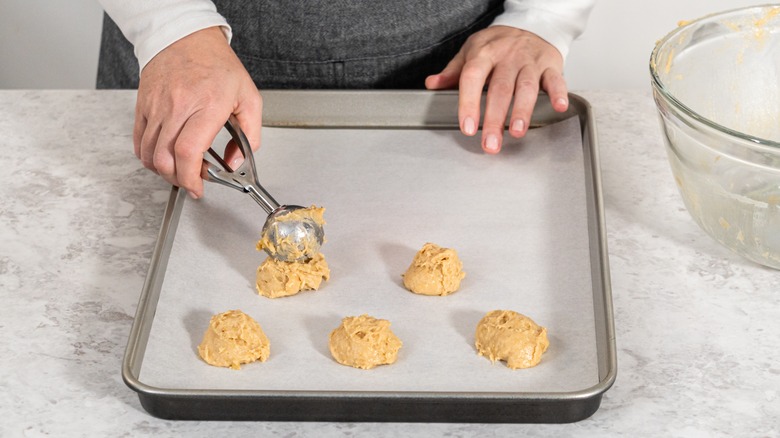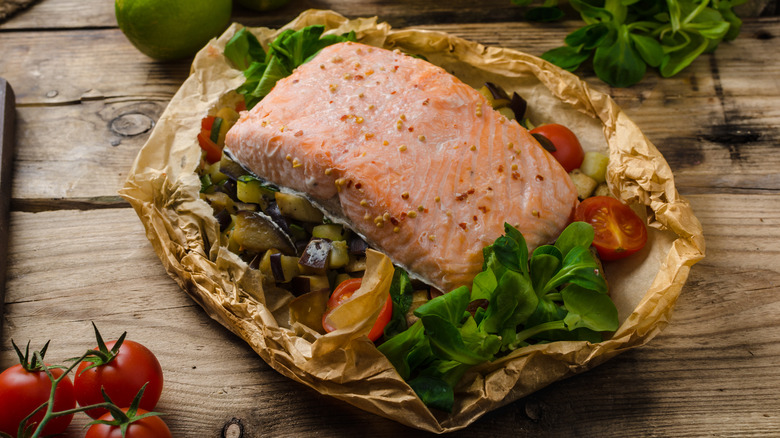How Ina Garten Prefers To Line Her Sheet Pans
While we all want to minimize the time spent scrubbing sheet pans after baking or roasting, whether and how you line the pans can significantly affect the recipe. Depending on what you are making, home cooks have several options, including aluminum foil, parchment, and nonstick silicone baking mats, commonly referred to by the brand name Silpat. Each has its purpose, but it's a mistake to assume they are interchangeable.
In an interview with Kerry Diamond on her podcast, Radio Cherry Bombe, Ina Garten shared that sheet pans are her most used kitchen tool and that she keeps a stack of them to roast chicken, vegetables, and every other delicious thing the Barefoot Contessa puts in the oven. Unlike Martha Stewart, who raves about using Silpat, Garten has never owned or used the durable liners and doesn't plan on starting now.
When asked what she lines her sheet pan collection with (since they always look new), Garten answered, "Just parchment paper or nothing, depending on if I need the surface." While nonstick silicone baking mats are the greenest option, washed and reused thousands of times, for most recipes, Garten is wise to use parchment.
Parchment is rated to be used below 450 degrees Fahrenheit, which takes care of most of your baking and roasting needs. Since it is flammable, avoid using it at higher temperatures or around open flames like pizza ovens. In those applications, aluminum foil with the shiny side down can be used to minimize cleanup.
Parchment versus Silpat
Since silicone baking mats are reusable, there's an economical and eco-friendly argument for using them. They provide a layer of insulation between the ingredients and sheet pans, which can be beneficial if you have dark pans prone to burning. However, that fiberglass layer lowers the sheet pan's surface temperature, increasing the cooking time and affecting the Maillard reaction. Since the pan's surface isn't as hot, roasted vegetables and proteins won't brown as effectively as when the pan is bare or lined with aluminum foil or parchment paper. While parchment adds a small layer of insulation, it doesn't affect the results and still provides a nonstick surface and easy cleanup. Celebrity chef Alton Brown weighed in on the debate via X (formally known as Twitter), saying he "Vastly prefers parchment."
When baking cookies, the slick surface of nonstick silicone mats enables the dough to spread faster than when using parchment paper. Since the dough has nothing to grip, the diameter of a cookie baked on silicone versus parchment paper will be greater. The dough doesn't have time to "puff," so it bakes faster than anticipated, often resulting in thin, overbaked, or burnt baked goods.
Silicone's nonstick surface allows sticky caramel and delicate tuiles to slide off with minimal effort. If you've washed one, you know exactly what we are talking about. While these recipes may be the ideal application for silicone baking mats, using them for all your cookie baking and roasting can ruin your recipes.
Additional uses for parchment paper
In addition to keeping your sheet pans looking like new, parchment paper has other applications. Use it to make "en papillote," individual meal packets that use steam to cook ingredients in the oven. This French version of a one-pot meal combines everything you need to make a healthy, flavorful recipe, requiring little fat in an easy-to-clean, disposable package. Try our salmon en papillote with persillade recipe for a delicious fish dish topped with a sauce reminiscent of chimichurri.
Parchment paper is the insurance policy to help cakes and brownies be effortlessly removed from baking pans. No more scratching the non-stick interior as you try to coax a less-than-perfectly greased layer cake from it. Parchment paper can also line cupcake tins when you run out of liners. Cut the parchment into five-inch squares and use a juice glass to mold the paper to the cup's shape.
For those of us who are concerned about the waste, we have some good news. Although parchment is disposable, it doesn't need to be discarded after each use. While you should not be reusing parchment paper in contact with raw meat or dairy, you can reuse the sheet liners when baking cookies and other baked goods until they fall apart. Simply wipe any food residue and grease before reusing or use unbleached parchment paper, which is biodegradable.



